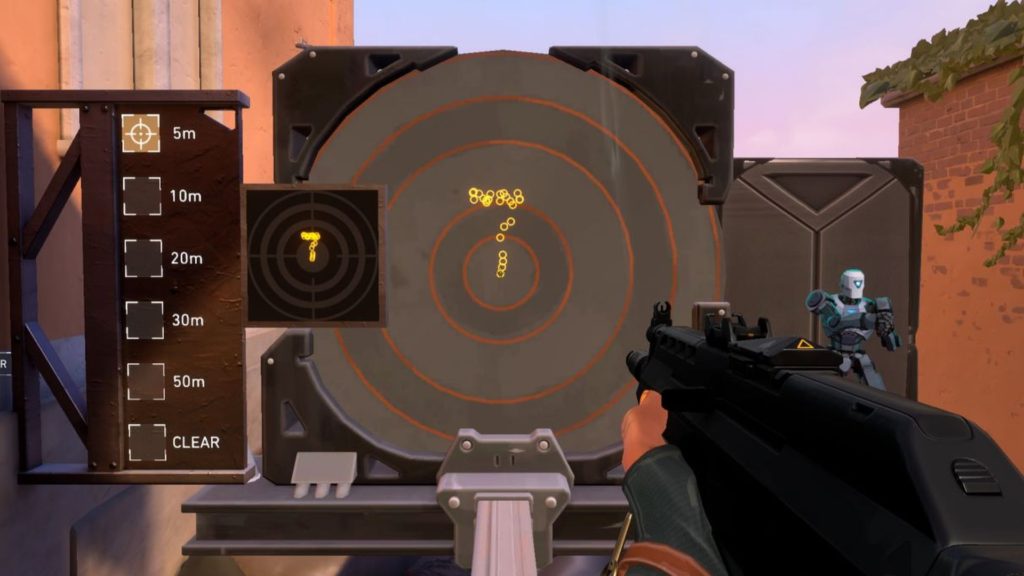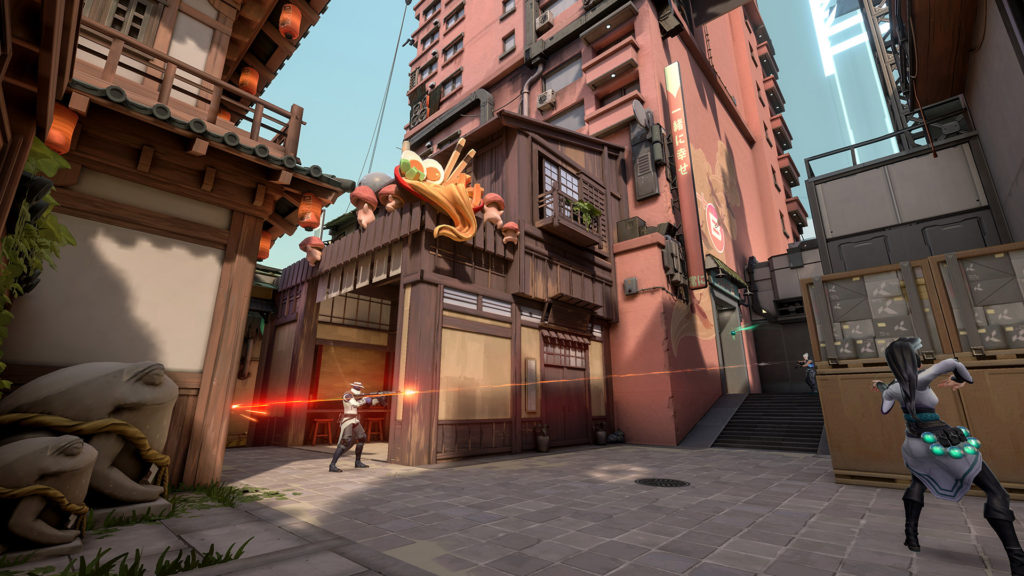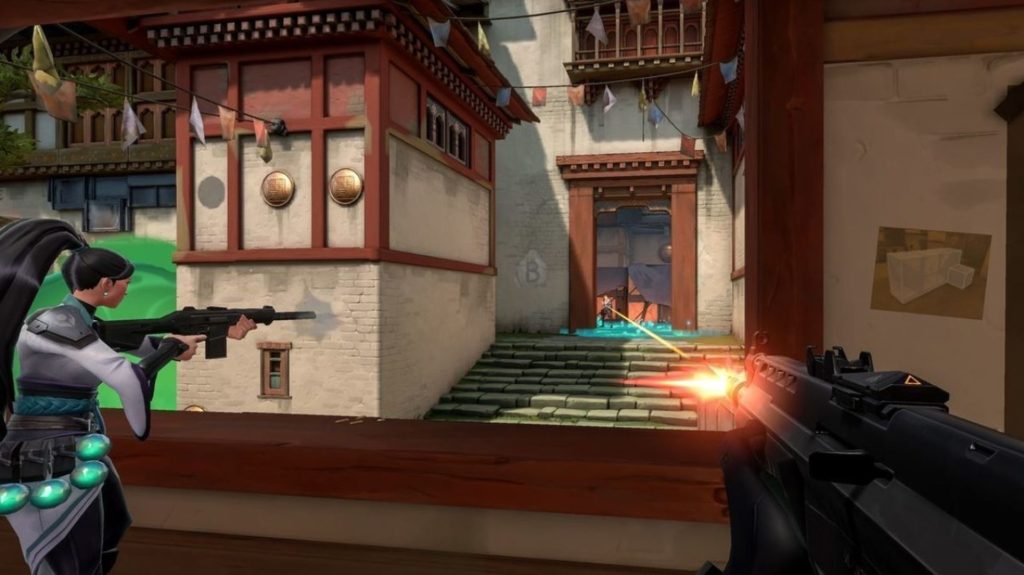
The other team’s Viper wasn’t expecting me to be up in the air when she came around that corner. We’d engaged in that same area several times, and I hadn’t done it once. She probably knew I could, of course. You play a few games of Valorant and you’ll see people use Jett’s Updraft ability to shoot themselves up in the air. But she was looking for an opponent on the ground because that’s how our previous engagements had gone. I knew she would have a light machine gun. She knew I’d carrying an assault rifle or a semi-automatic. We’d done this dance before. I landed just to her left, out of her vision. By the time she realized where I was, she was already dead, and I was moving on to the next area to hunt down her last surviving teammate.
Moments like this exemplify Valorant at its best: when your knowledge of your abilities, the game’s weapons, and the other team’s tactics come together to create small moments of perfection. I’ve had a dozen of these moments in my time with the game. Jumping over an enemy’s shots and shooting them in the head to defend our spike and win the round; killing four members of their team in rapid succession; nailing the perfect spike plant and holding them off long enough to escape; managing to come back in games where I was playing horribly. Don’t get me wrong, there’s been rough moments, too. Games where my team and I were absolutely demolished, or ones where we won and I played badly. But the moments I come back to are the little triumphs, the ones where I could see I was getting better. I couldn’t tell you whether we won or lost the games I pulled those specific examples from, but it doesn’t matter. They’re going to stick with me long after the score screen.
"You’re most accurate when you’re standing still, which means running into battle guns blazing is usually a one-way ticket. Instead, you’ll want to stand still – or at the very least, walk slowly – and aim for the head."
In case you’ve been living under a rock for the last couple of months, Valorant is the newest release from Riot Games, the developer of League of Legends. Unlike League, Valorant is an FPS. The easiest way to describe it would be a combination of the heroes and abilities from Overwatch with the core gameplay of Counter-Strike. The game consists of two five man teams. One team has to plant a spike (read: bomb) at certain sites on the map, which vary from two to three in number. The other team has to defend them. The attacking team can win by killing the entire defending team or detonating their spike. The defending team wins by killing the attacking team, ensuring the spike is never planted, or disarming a planted spike. After 12 rounds, the teams switch sides, and the first team to win 13 rounds wins the game.
Everyone starts off with a pistol and a knife, but you’ll gain money the end of every round. Getting kills ($200 a pop), winning a round ($3000), planting a spike ($300 for the entire team), defusing a spike ($300), losing a round ($1900-$2900, depending on how many rounds you have lost in a row) earns you cash that can be spent between rounds on armor, guns, or abilities. If you managed to survive the last round, whatever you had will carry over to the next one.
You’re most accurate when you’re standing still, which means running into battle guns blazing is usually a one-way ticket. Instead, you’ll want to stand still – or at the very least, walk slowly, though this will still reduce your accuracy – and aim for the head. You die very quickly in Valorant – most guns will kill in 1-2 headshots – so accuracy is a must. It’s better to take a second and aim than fire before you’re ready, though reflexes do play a role here. You’re also going to want to be quiet. You sprint by default in Valorant, which is noisy and makes it easy for enemies to figure out where you are, but you can walk by holding the shift key. You’ll want to do this most of the time, so you can get the drop on enemies.
"Rounds are mostly cat and mouse affairs that depend on positioning, skill, and a little luck as you try to suss out where the enemy team is so you can take them down."
Rounds are mostly cat and mouse affairs that depend on positioning, skill, and a little luck as you try to suss out where the enemy team is so you can take them down. They’re pretty quick – lasting only a couple minutes a round – so there’s a push to get things done. Communication with your team is key, as is spending your money wisely. In some rounds, you’ll want to conserve money. In others, you’ll want to spend big. Knowing when to do that – and coordinating with the rest of your team – makes a huge difference. What kind of guns you pick matter as well. I preferred the Guardian, a single-shot rifle that kills with one shot to the head, but there’s no wrong answer. The Phantom, another of my go-tos, is an automatic rifle that’s accurate and does high damage in short bursts. You might opt for the Judge, an automatic shotgun that’s peerless at close range, or the Ares, and LMG that’s fairly cheap and accurate at close range. Maybe the high damage Vandal (Valorant’s take on the Ak-47) is more your style, or you prefer the Operator, a sniper rifle that can kill in a single body shot.
No matter what you choose, you’ll need to learn the ins and outs of each gun. How accurate is it at range? How about close up? How many shots to kill? Do I need to hit the head, or do body shots work? Most importantly, how much should I cost, and when do I take it? All of Valorant’s guns feel incredible – chalk this up to the game’s excellent sound design and fantstic reloading and firing animations – and they’re a treat to use, but you will need to put in some work to master the game’s arsenal.
Valorant would be a deep game without its Agents (read: heroes), but they make it even more complex. There are currently eleven in the game, each with four abilities. You’ll have their signature ability each round for free, but you’ll have to purchase the other two in the shop with cash. The final is your ultimate ability, which is charged by killing enemies (one point per kill), picking up ultimate charges on the map (which gives one point to every member of your team), or just earned passively as rounds go on. Between 6-7 charges are required per ultimate, so they take a while unless you’re racking up kills, but they’re pretty strong.
"Valorant isn’t overflowing with modes. Besides the practice mode, there’s an unranked version of the core mode, Spike Rush –a lower stakes, 4-rounds-to-win mode with randomized loadouts and more ultimate pickups – and custom games. That’s it."
Naturally, who you play makes a big difference. Sage is a utility character that heals her teammates, creates walls of ice, forms patches of ice that slow enemy movement, and resurrects fallen teammates. Jett is more combat focused, and can create clouds that obscure vision, shoot herself up in the air, dash forward, and throw a series of knives that do high damage once her ultimate is charged. Raze focuses on explosives, with exploding satchel charges robot bombs, and grenades, while Brimstone can call in ordinance from on high and buff his allies. Viper specializes in poison that controls areas. Others, like Cypher and Sova, help their teammates locate enemies. Each of them plays differently, and their abilities can turn the tide of a round when used properly, but overall, your choice of character isn’t as important as your ability to coordinate with your teammates, land headshots, and play smart. That’s a good thing, since the limited character choice means that you won’t always get to use your favorite. Learning other heroes is a must, and it will help you play against them better, too.
Thankfully, Valorant is pretty good about helping you learn to play it. The tutorial will walk you through the basics, and unfortunately can’t be replayed, but you can always go to The Range, which is where its set, and practice manually. Here you’ll be able to play with every character (even if you haven’t unlocked them), test every gun, work on your accuracy, and more. It’s a pretty great practice area, and you’ll probably spend a lot of time here as you learn the ins and outs of every hero.
No amount of practice is a substitute for combat experience, though, and sooner or later you’re going to have to jump into a real game. Valorant isn’t overflowing with modes. Besides the practice mode, there’s an unranked version of the core mode, Spike Rush –a lower stakes, 4-rounds-to-win mode with randomized loadouts and more ultimate pickups – and custom games. That’s it. Whatever you play, know that you’re probably going to die a lot. Even then, it might take some time before you’re comfortable with all the maps. This is a game with a high learning curve, and it’s not easy to play. This makes sense – Riot is marketing this to the hardcore and esports crowds – but you should have an idea of what this is going in. I got a lot better over my first few hours, but I’ve still got a long way to go, and I feel like most players will feel that way, unless you spent a lot of time in the game’s beta.
"The much harder sell is Vanguard, Riot’s anti-cheat program for Valorant. The long and short of it is that Vanguard is always on. It starts with your computer and stays on even when you’re not playing."
As good as Valorant feels, it does have issues. I like the way most of the cast looks, but they lack the flair of the best heroes of Overwatch or even League of Legends. Speaking of, you only start with five of them. The rest are free to unlock, but it takes time. As a new player, this means you’re incentivized to lock in your choice immediately, lest you be stuck with whoever’s left. You also can’t unlock once you’ve locked in, so even if your teammates would be open to switching to help you out, you’re stuck. Similarly, there are only four maps, and none of them are particularly visually exciting. They’re well-designed, and Riot has done so well nailing down Valorant’s fundamentals that most won’t care, but it’s worth pointing out.
There are microtransactions, but they’re limited to weapon skins and fairly reasonably priced. $5 gets you 475 Valorant Points. Some skins cost as much as 875 VP, while others are bundled with things like exclusive logos and sprays for much more. There’s also a Season Pass, if you’re into that. It’s a bit baffling there’s no option to buy characters, especially given the limited number you start with. If you don’t like a character you unlock, tough. You’re stuck waiting until the next one. On a more positive note, however, there are no loot boxes of any kind.
The much harder sell is Vanguard, Riot’s anti-cheat program for Valorant. The long and short of it is that Vanguard is always on. It starts with your computer and stays on even when you’re not playing. You can disable it, but you’ll have to restart your computer if you want to play Valorant. The worst part is that Vanguard operates in the kernel, or ring zero, of your PC. That’s the most privileged level of access, meaning Vanguard has access to every part of your PC’s hardware. From ring zero, you can modify system memory, access another user’s files, or crash the entire system. Vanguard worked fine for me, but there are reports of it crashing – and when I say crashing, I mean blue screen of death levels of crashing – people’s computers as it stops harmless programs from operating. The is idea is that ring 0 access will stop the injection of cheating software at ring 3, the user level. The problem is that when cheat developers also move into the kernel, Vanguard can’t stop them.
"There’s been cheating in Valorant since week 1, so Vanguard’s level of access isn’t a guarantee of success. "
There’s been cheating in Valorant since week 1, so Vanguard’s level of access isn’t a guarantee of success. It also encourages cheaters to target kernel level access. Now, other anti-cheat programs like Easy Anti-Cheat and BattlEye also use kernel level access, but they only run when the games using them are running. There are other anti-cheat programs that operate like Vanguard, like ESEA or FACEIT, but they’ve been around a lot longer, and constant updates have made them feel less invasive. The real question about Vangaurd is this: how much do you trust Riot Games? More importantly, how much do you trust Tencent, the Chinese technology conglomerate that owns them? Because if Vanguard is running, they have full and complete access to everything on your computer. And unless you turn it off, it’s always running. That’s a question everyone will have to answer for themselves, but I’d be lying if the level of access Vanguard has didn’t concern me, especially since it’s not stopping people from cheating.
It’s a shame we have to talk about that, because Valorant is a great game. It’s easy to understand, and difficult to master. It doesn’t have the visual chops of Overwatch, or even Riot’s own League of Legends, and it definitely doesn’t have the level of backstory they do. But it is a very good, and very fun, free-to-play game. The learning curve will put some people off, but it’s tough not to recommend Valorant, even with its flaws. Whether you trust Riot Games with the level of access they demand to let you play it is up to you.
This game was reviewed on PC.
Strong gunplay makes shooting fun. Matches are intense. Lots of depth. Characters are fun to play. Maps are well-designed. Rewards skill.
Intrusive anti-cheat program that has access to everything on your PC. Only four maps and modes. Extremely high learning curve. The art design is just okay. You only start with five characters.




















